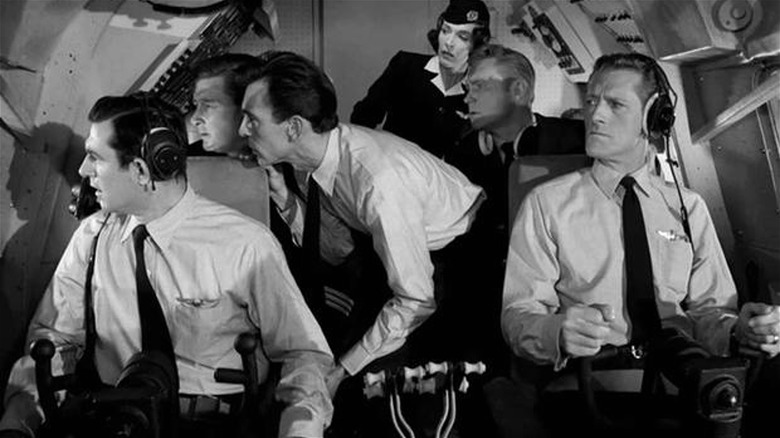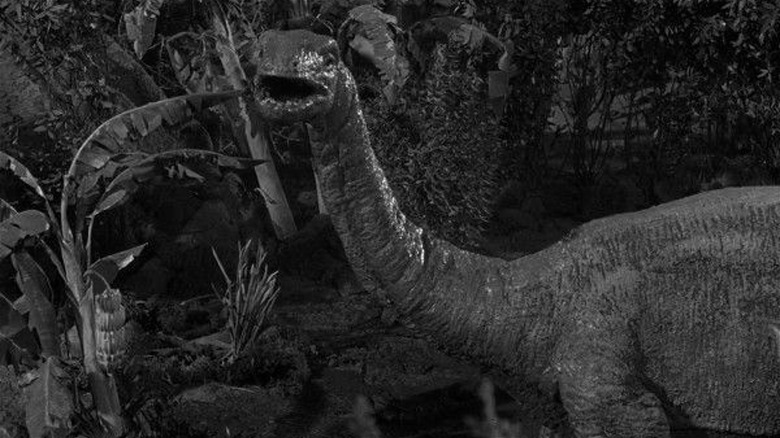Rod Serling's Brother Was Responsible For One Of The Twilight Zone's Best Episodes
An airplane, Flight 33, is en route from London to New York City on what seems to be an uneventful trip. Captain Farver (John Anderson) notices that the aircraft is increasingly gaining ground speed, but it poses no real danger to the plane or the crew. After a brief flash of light and turbulence, Farver descends lower to scope out the scenery beneath. He's met with a most shocking sight: droves of dinosaurs roam the terrain, cementing the fact that Flight 33 has somehow traveled through time to the prehistoric era. This is the crux of the 54th episode of "The Twilight Zone," "The Odyssey of Flight 33."
How did the idea for such an intriguing episode concept come about? Series creator Rod Serling was struck with the inspiration for "The Odyssey of Flight 33" while his brother, aviation writer Robert Serling, had come to visit him. In The Twilight Zone Companion by Marc Scott Zicree, Robert recalls the details of the meet-up, where his brother presented the premise after receiving a brochure from American Airlines:
"There was some mail on his desk...and on the top was an envelope from American Airlines. It was a brochure offering a mockup of a 707-passenger cabin to any studio that was going to film a scene...We're driving and he's still looking at this brochure. All of a sudden, he closes it and says, 'Bob, suppose you had a jet over the Atlantic and it picked up a freak tailwind of such velocity that its ground speed was something like eight thousand miles an hour, and it went so fast that it went through a time barrier, and...they were back in prehistoric times.'"
This was the beginning of Robert's involvement with the episode, which he helped shape in meaningful ways.
Shaping an idea
Weeks after this encounter, Rod called his brother to ask for advice regarding "cockpit dialogue," as he wanted it to sound as authentic as possible. In turn, Robert offered that he could look into radio checkpoints to get a better understanding of terms like "groundspeed" and "true airspeed," so that the dialogue went hand in hand with the time-space glitch that occurs. After some digging, the brothers worked on said dialogue together while acting out the roles to make the story feel as seamless as possible. The experience was also enriched with feedback from professional pilots:
"Somewhere, he's [Rod] got letters from some pilots who said it was the most technically accurate piece that anybody had ever done on an airplane flight. It was. The checkpoints were perfect; the dialogue was just what a crew would say."
With technical accuracy out of the way, Rod was able to craft a gripping tale that was grounded with subtle performances, backed by smartly edited aerial stock footage of the 1939 New York World's Fair, which was used to denote the crew's unsuccessful attempt to travel back to the present. A lot of effort also went into creating two bird's-eye shots of a Brontosaurus, which was made possible with the help of miniature landscapes and a scaled model of the dinosaur brought to life with stop-motion animation.
Thanks to Robert Serling, "The Odyssey of Flight 33" still feels viscerally haunting, especially in the way it authentically captures the "cockpit dialogue" that helps lend authenticity to a conventional time travel trope that was often used to convey the surreal nature of being stranded in the wrong timeline. Whether Flight 33 made it back to the present still remains a mystery: the aircraft could suddenly reappear in the sky or be forever lost in the Twilight Zone.

